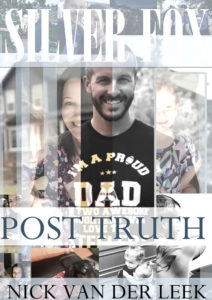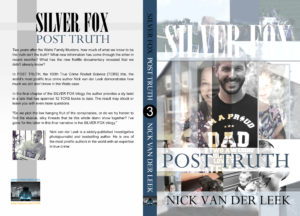How the Vital Lie of Character connects all of us to the Criminal Mind – Patreon
True Crime Analysis, Breakthroughs, Insights & Discussions Hosted by Bestselling Author Nick van der Leek
Tag: Character
Everyone knows what interiority is, although not all of us know that we know. To know what it is, we can start by saying what it isn’t. The opposite of interiority is exteriority: it’s the quality or state of being exterior or exteriorized.
Exteriority is what we see on Facebook, what we see at face value when someone has plastic surgery, and when we dress up to go to an important meeting. It’s Chris Watts giving his Sermon on the Porch. What we see on the outside, the face Chris Watts gives his questioners and his version of events isn’t necessarily the true face, in fact, it may be very untrue.
Interiority is the cosmos that’s unseen. It’s hidden, but it’s in many ways more real than what is seen [and what is seen to be real]. In true crime, interiority is probably the most underestimated and underutilized tool, and yet almost everyone is chasing after it, we just don’t know it.
Well, thanks True Crime Rocket Science, now you do.
It’s important to start with the basics; to know what we’re chasing after, and to define it, so that we can say either we’ve found it [if we ever do], or we can set up solving the problem of why it eludes us.

We will get less theoretical and more practical in a moment, but first we need to orient ourselves on the issue of exactly where interiority fits into the fuzzy business of profiling.
Again, don’t be put off my these dry-academic sounding terms. Think about this in the context of setting up a Facebook profile, or a Twitter profile. Our profile is a clunky way of telling the world who we are. First, we want to identify ourselves. Then we want to communicate what wonderful characters we are, so wonderful in fact that we’re better than some. Under the lie of character is a more solid foundation, that of personality. No matter who we say we are, or pretend we are, personality tends to leak through via set things like a dark sense of humor, or how introverted or inhibited we are, or our particular thresholds for fun, abuse or sex.
Interiority lies underneath all of these, almost like the yolk within a hardboiled egg. Our interiority is really who we are, and it’s also what we least like to reveal, hence the need for a shell and several layers of personality and character armor. Although interiority must manifest in some way into our authentic identities, who we appear to be [or we we say we are to the opposite sex, or on social media] is really dependent on how we see ourselves, and what we sell ourselves. Interiority tends be hidden even – especially – when we’re trying not to hide it.
In the above sketch character is analogous to the shape we construct of ourselves, and convey to others. Often the outline is an exaggeration, an inflation of the actual silhouette of the self. Unlike an actual egg shell, the character shell tends to shapeshift over time. The personality is the wobbly white layer underneath, it’s counterintuively more fixed than the character armour, but even so it’s not really getting to the golden center of who a person [or criminal] really is. Interiority provides the color, and just as it relates to eggs, its the bright gooey center where everything happens that matters.
The yolk is where life rises and manifests and becomes what it is, everything else is ancillary.
Another way of putting it – interiority is the skeleton holding together the tissue, the tree onto which the flesh anchors itself. If exteriority is loud, interiority is silent.
In the original True Detective series, Rust is by far the more introspective when compared to Marty. But over time, Rust has an influence on Marty, making him more sober about how he sees himself and others.

Now let’s get practical about this amazing psychological tool. In many respects, the Watts case is the epitome of exteriority. The fairy tale social media, the loud, expressive optimism of the neon colored Thrive patches and promises, and the focus on their appearances – both in terms of Mr and Mrs Watts.
What we want to know is what lay beneath that? Consider the parlance of the oil industry, a business that is entirely preoccupied with the interiority of the Earth.

It refers to elevators, fish, mud, pigs, worms, wells, treaters, hitches, moon pools, pay and kills, but none of these words mean what they do in our world. An elevator is a mechanism that closes around a drill pipe, fish refers to broken drilling ordinance, mud is drilling fluid, pigs are devices inserted into pipelines for cleaning, hitches are rig employee shifts, moon pools aren’t pools on the moon but pools on the ocean floor., pay is the rcash cow portion of a reservoir where the resources are buried, and a kills are those actions that stop or prevent a well from flowing [or leaking].

If this was the language Chris Watts was exposed to, how much of his world are we really aware of? And as for Shan’ann, well, there seems to be a reluctance by the living to prognosticate on the interiority [good or bad] of a murder victim. It’s seen as distasteful to want to know who someone was after they’re dead when a nice smiling photo will do. That’s the dominion of exteriority for you.
There is a way to delve deep inside the Watts family’s interiority, or at least just to acknowledge it, but to achieve this I’m going to have to trick you, to do a mindjob on you. Don’t worry, once it’s done you’ll know and who knows, you might thank me for it later.
Ready?
Understanding the Interiority of a Cat
True story. Over the past week I’ve been babysitting a friend’s cat. While researching these issues of identity it was inevitable that I’d start to test these thoughts on my new and temporary house guest. Since cats can’t speak, how do we know who they really are? Well, through their interiority.
This cat, who hasn’t been named yet, is male, first of all, and as cats go, very good natured. Often cats are independent and bristle at too much human contant, but this fellow is very companionable. He’s still he’s own person, and likes to do his own thing, and likes to play, but he’s just as comfortable giving attention as he is receiving it.
He’s no pushover though. When I have a tall glass of water beside my desk, he’ll dip his chin into it and out comes the little triangle of pink tongue. When I added the glass of water to a shorter glass, which had a little milk residue in it, the cat wouldn’t touch it. It no longer looked potable. His toilet habits are similar. His owner dropped off a tub with fragrant gravel, almost like taking a shit in a sand dune of washing powder. Kitty didn’t like that either; instead he found a decent potplant with real soil in it, and did his business there. This cat’s got standards.
Perhaps the most fascinating aspect was the cat’s need to be let outside. Some cats are introverts and homebodies, not this one. Although he naps like the best of them, he’s definitely a roamer, and likes to hunt. His owner says he recently caught a local bird – a Hoepoe – and the trauma of seeing and hearing this incredible creature bleating for its life while having its feathers ripped from its body still lingers. So in spite of a cat’s sweet nature, it’s also – fundamentally – a hunter. A killer. That’s who he is and who he wants to be. That’s what excites him most, and when he plays, he’s playing at the idea of hunting. And killing.

For reasons I won’t go into here, the cat had to be chaperoned during its scheduled time outside of jail. Since the security complex I stay in is like a honeycomb, the risks of it getting lost are high, and so, for its own good, the cat has to be repressed, limited, trapped inside someone else’s scheme for what’s good for the cat.
Whether this is what’s best for the cat is unclear; if the cat could talk he might say: Fuck you, if I go out I’ll find my way back. I don’t need to be supervised asshole. But since he can’t talk, and since his owner found him precisely because he went on an extended walkabout, I’ve had to curtail his freedom.
There’s a lot more to go into, his annoying habits, his manners, his sleeping, eating and shitting patterns. One particularly annoying habit is the cat’s horniness, but it’s also a reminder that cats [like people] are only human after all. They have to do something with those impulses, and when you’re locked indoors against your will, and your nature, well, something’s got to give.
See what I just did there?
We’re far more comfortable discussing and acknowledging the interiority of a cat. When we do this with people we feel we’re being judgmental or projecting stereotypes – whatever it is people find it objectionable. What we’re doing when we’re exploring interiority is trying to put together a profile. Profiling may not be nice in the real world, but it happens all the time. Voters are profiled, recruitment agencies profile their employees, we profile ourselves continually on social media while stalking those of others. We just don’t like to admit that it happens.
Profiling in true crime isn’t an option. If we want to get to the authentic narrative, we have to develop a better profile than the one the criminal offers to us. But because we avoid doing this in polite society, we’re a bit rusty when we’re called on to evaluate people in true crime. Also, there’s an inference that interiority doesn’t exist, or that it’s not important, and so it often falls by the wayside.
In fact interiority is the most important aspect in true crime, because it’s the actual subjective experience of the criminal’s world, the way he sees others, and himself in his world. It’s also by far the most undiscovered country in true crime. #TCRS uses interiority to drill down through the shell, penetrate till we hit paydirt, and then we can extract this inner world and pump it to the surface.
In conclusion: From this brief interlude into this cat’s life, I was surprised what a complex “person” even a small animal can be. If animals have their own highly developed interiority, and we know how deeply that impacts on a person inside their home, imagine how the interiorities of people inside a home bubble, froth and fizz over time like chemicals in confined spaces. Chemical reactions are inevitable.

And so, in my analogy, just as I’ve trapped a cat in my-agenda-of-what’s-best-for-him, he’s also trapped me. I’ve constantly got to monitor, control and supervise him, since I’m not willing to trust him and not willing to give him the freedom to be fully his cat-self. We’re both trapped in an agenda, my agenda, which is born of a particular skewing of one’s interiority. Since kitty has been here, I haven’t been able to come and go as I please either, or leave doors open, and his miaowing at night [to go out] hasn’t been fun. Over the course of a week it’s been exhausting, like having a small child around.
When we hold someone or something prisoner, the jailers become prisoners too. And as the weeks roll into months, months into years, two contesting interiorities can completely and utterly exhaust one another. Is it a coincidence that Shan’ann died so late at night, so long before the day? It was late in the lifetime and the life expectancy of their marriage too, wasn’t it? If so, then somehow the marriage gad been artificially extended way past its sell-by date.
Who would have done that? Would would have the most to gain or the most to lose by doing that? Interiority is the key to finding these answers.
Someone in the Watts home was keeping someone else in jail – excessively – and it led to murder most foul.

© 2025 TRUE CRIME ROCKET SCIENCE
Theme by Anders Noren — Up ↑











Recent Comments